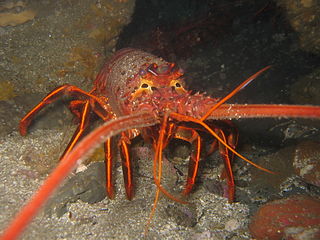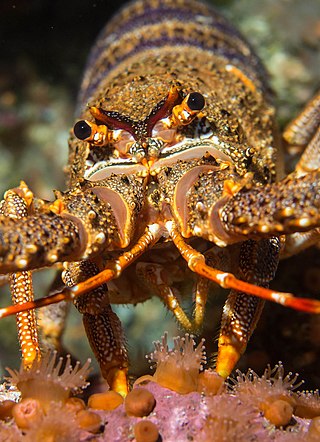
Spiny lobsters, also known as langustas, langouste, or rock lobsters, are a family (Palinuridae) of about 60 species of achelate crustaceans, in the Decapoda Reptantia. Spiny lobsters are also, especially in Australia, New Zealand, Ireland, South Africa, and the Bahamas, called crayfish, sea crayfish, or crawfish, terms which elsewhere are reserved for freshwater crayfish.

The California spiny lobster is a species of spiny lobster found in the eastern Pacific Ocean from Monterey Bay, California, to the Gulf of Tehuantepec, Mexico. It typically grows to a length of 30 cm (12 in) and is a reddish-brown color with stripes along the legs, and has a pair of enlarged antennae but no claws. The interrupted grooves across the tail are characteristic for the species.

Jasus edwardsii, the southern rock lobster, red rock lobster, or spiny rock lobster, is a species of spiny lobster found throughout coastal waters of southern Australia and New Zealand including the Chatham Islands. It is commonly called crayfish in Australia and New Zealand and kōura in Māori. They resemble lobsters, but lack the large characteristic pincers on the first pair of walking legs.

Lobsters are widely fished around the world for their meat. They are often hard to catch in large numbers, but their large size can make them a profitable catch. Although the majority of the targeted species are tropical, the majority of the global catch is in temperate waters.

Slipper lobsters are a family (Scyllaridae) of about 90 species of achelate crustaceans, in the Decapoda clade Reptantia, found in all warm oceans and seas. They are not true lobsters, but are more closely related to spiny lobsters and furry lobsters. Slipper lobsters are instantly recognisable by their enlarged antennae, which project forward from the head as wide plates. All the species of slipper lobsters are edible, and some, such as the Moreton Bay bug and the Balmain bug are of commercial importance.

Panulirus cygnus is a species of spiny lobster, found off the west coast of Australia. Panulirus cygnus is the basis of Australia's most valuable fishery, making up 20% of value of Australia's total fishing industry, and is identified as the western rock lobster.
Palibythus magnificus, sometimes called the musical furry lobster, is a species of furry lobster found in Polynesia. It is generally included in the family Palinuridae, although it has also been separated from that family with the genus Palinurellus to form the family Synaxidae in the past. The species is known in Samoan as ula moana, a name which also covers the deep-water shrimp Heterocarpus laevigatus.

Metanephrops challengeri is a species of slim, pink lobster that lives around the coast of New Zealand. It is typically 13–18 cm (5–7 in) long and weighs around 100 g (3.5 oz). The carapace and abdomen are smooth, and adults are white with pink and brown markings and a conspicuous pair of long, slim claws. M. challengeri lives in burrows at depths of 140–640 m (460–2,100 ft) in a variety of sediments. Although individuals can live for up to 15 years, the species shows low fecundity, where small numbers of larvae hatch at an advanced stage.

Palinurus elephas is a commonly caught species of spiny lobster from the East Atlantic Ocean and the Mediterranean Sea. Its common names include European spiny lobster, crayfish or cray, crawfish, common spiny lobster, Mediterranean lobster and red lobster.

Panulirus versicolor is a species of spiny lobster that lives in tropical reefs in the Indo-Pacific. Other names include painted lobster, common rock lobster, bamboo lobster, blue lobster, and blue spiny lobster. P. versicolor is one of the three most common varieties of spiny lobster in Sri Lanka, alongside Panulirus homarus and Panulirus ornatus.

Jasus lalandii, the Cape rock lobster or West Coast rock lobster or South African rock lobster, is a species of spiny lobster found off the coast of Southern Africa. It is not known whom the specific epithet lalandii commemorates, although it may the French naturalist and taxonomer Pierre Antoine Delalande.
This page is a list of fishing topics.

Sagmariasus verreauxi is a species of spiny lobster that lives around northern New Zealand, the Kermadec Islands the Chatham Islands and Australia from Queensland to Tasmania. It is probably the longest decapod crustacean in the world, alongside the American lobster Homarus americanus, growing to lengths of up to 60 centimetres (24 in).

Macroctopus maorum is known more commonly as the Maori octopus or the New Zealand octopus. It is found in the waters around New Zealand and southern Australia. M. maorum is one of the largest and most aggressive octopus species living in the New Zealand and Australian waters. They feed mainly on crustaceans and fish. Although they have a short life span, the females lay thousands of eggs and are very protective of them.
Jasus caveorum is a species of spiny lobster found on a single seamount in the southeastern Pacific Ocean, discovered in 1995 by fishermen from New Zealand. It is most similar to Jasus frontalis from the nearby Juan Fernández Islands, but is more closely related to species from the Atlantic and Indian Oceans.

Panulirus brunneiflagellum is a species of spiny lobster that lives around the Ogasawara Group of southern Japan. Its members were previously included in P. japonicus, although it may be more closely related to P. femoristriga. It has been fished for more than 150 years by Japanese fishermen, who call the species aka-ebi. It differs from related species by the lack of banding along the flagella of the first pair of antennae.

Panulirus ornatus is a large spiny lobster with 11 larval stages.
Jasus frontalis, known as the Juan Fernández rock lobster, is a species of spiny lobster in the genus Jasus, found around the Juan Fernández and Desventuradas Islands in the south-eastern Pacific Ocean.

Jasus paulensis, also commonly known as the St Paul rock lobster, is a species of spiny lobster found in the waters around Saint Paul Island in the southern Indian Ocean and around Tristan da Cunha in the southern Atlantic Ocean. At one time the rock lobsters on Tristan da Cunha were believed to be a separate species known as the Tristan rock lobster, but the use of mitochondrial DNA sequencing has shown them to be identical. Some authorities, for example the International Union for Conservation of Nature, retain them as separate species. The Tristan rock lobster features on the coat of arms and the flag of Tristan da Cunha.
Cecil von Bonde was a South African zoologist, fisheries scientist and oceanographer.

















